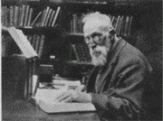
Charles Davies Sherborn (1861-1942) The Society’s first President
2011 was the 150th anniversary of the birth of Charles Davies Sherborn, first President of this Society (when it was founded in 1936 its name was Society for the Bibliography of Natural History).
An article in the Telegraph and the NHM house journal evolve celebrated Sherborn in his anniversary year: www.telegraph.co.uk/science/8646534/Charles-Davies-Sherborn-the-Natural-History-Museums-magpie-with-a-card-index-mind.html.
We celebrated Sherborn’s life with a one-day symposium entitled “Anchoring Biodiversity Information: From Sherborn to the 21st century and beyond” on Friday 28 October 2011 at the Natural History Museum in London.
Charles Davies Sherborn was the eldest son of Charles W. and Hannah (née Davies) Sherborn, and was born in Chelsea on 30th June 1861. His father was an engraver and etcher. A brief biography by R. J. Cleevely was published in Archives of natural history 36 (2009) [www.euppublishing.com/doi/abs/10.3366/E0260954109001089], and there are reminiscences of Sherborn by Francis J. Griffin in Journal of the Society for the Bibliography of Natural History 3 (1953) [http://www.euppublishing.com/doi/abs/10.3366/jsbnh.1953.3.1.np]. A comprehensive biography of Dr Sherborn, by another founding member of this Society, John Roxborough Norman (1896–1944), entitled Squire: memories of Charles Davies Sherborn, was published in 1944.
Sherborn’s interest in natural history was mainly within geology and zoology, and as Cleevely points out, with limited resources for fieldwork, he devoted considerable time to bibliographic work and catalogues. For example, he published A bibliography of the Foraminifera … [www.biodiversitylibrary.org/item/36519] in 1888 and, as co-author with A. S. Woodward, A catalogue of British fossils Vertebrata in 1890 [www.biodiversitylibrary.org/item/74109]. However, Sherborn’s most remarkable work, compiled during a period of 43 years, was Index animalium, an indispensable work for zoologists akin to the botanists’ Index Kewensis.
That work’s full, portentous Latin title is Index animalium sive index nomimum quae ab A.D. MDCCLVIII generibus et speciebus animalium imposita sunt. Societatibus eruditorum adiuvantibus Carolo Davies Sherborn confectus. Publication of Index animalium began in 1902 and the ten-volume work was completed in 1933.[www.sil.si.edu/digitalcollections/indexanimalium/]
“The objects of [Index animalium] are (a) to provide zoologists with a complete list of all the generic and specific names that have been applied by authors to animals since January the first, 1758; (b) to give an exact date for each page quotation; (c) to give a quotation for each reference sufficiently exact to be intelligible alike to the specialist and to the layman.”
Sherborn continued: “Similar works have been produced before, but no one book has yet appeared attempting to supply references to all names given to both fossil and recent animals, nor has any definite attempt been made to fix an accurate date to each name.”
Following informal discussions over coffee in a local Lyons’ Tea Shop, presumably during the late winter of 1935–1936, on 14 March 1936 in the rooms of the Royal Entomological Society, South Kensington, the Society for the Bibliography of Natural History was established. On 26 August, the first Bye-Laws were adopted at a Special General Meeting, in which the Society’s object was set out:
The Society for the Bibliography of Natural History is a Scientific Society instituted exclusively for the study of the bibliography of all branches of natural history, including zoology, botany, geology , and mineralogy.
Dr Sherborn was chosen as its first President. He was one of the co-authors, with Francis Griffin and H. S. Marshall, of the first paper in the Journal – A catalogue of papers concerning the dates of publication of natural history books – and he contributed a dozen other notes and papers before his death on 22nd June 1942.
- 1936 [with GRIFFIN, F. J. and MARSHALL, H. S.] A catalogue of papers concerning the dates of publication of natural history books. J 1 (1): 1–30. [www.euppublishing.com/doi/abs/10.3366/jsbnh.1936.1.1.1]
- 1937 On the dates of publication of Costa (O. G.) and (A.) Fauna del Regno di Napoli, 1829–1886. J 1 (2): 35–47. [www.euppublishing.com/doi/abs/10.3366/jsbnh.1937.1.2.35]
- 1937 Palaeontology of Niti in the Northern Himalayas, being descriptions and figures of the Palaeozoic and secondary fossils collected by Col. Richard Strachey, R.E. Descriptions by J. W. Salter and H. F. Blanford. 8vo. Calcutta (Cutter, Military Orphan Press, 1864), 1865. Pp. 112, Pts. I–XXIII. J 1 (4): 108. [www.euppublishing.com/doi/abs/10.3366/jsbnh.1937.1.4.108]
- 1937 Dru Drury. J 1 (4): 109–111. [www.euppublishing.com/doi/abs/10.3366/jsbnh.1937.1.4.109]
- 1937 Brewster’s Edinburgh encyclopaedia. J 1 (4): 112 1938 [with TAMS, W. H. T.] Generic, trivial and specific names. J 1 (5): 130. [www.euppublishing.com/doi/abs/10.3366/jsbnh.1937.1.4.112]
- 1938 [with TAMS, W. H. T.] Generic trivial and specific names. J 1 (5): 130. [www.euppublishing.com/doi/abs/10.3366/jsbnh.1938.1.5.130a]
- 1938 Angelin, Palaeontologia Scandinavia. J 1 (5): 138. [www.euppublishing.com/doi/abs/10.3366/jsbnh.1938.1.5.138]
- 1938 Dates of books received: extracted from The gentleman’s magazine, 1758–1800. J 1 (5): 141–142. [www.euppublishing.com/doi/abs/10.3366/jsbnh.1938.1.5.141]
- 1939 Dates of Sedgwick and McCoy, Syn. classif. Brit. Palaeoz. rocks. J 1 (7): 194. [www.euppublishing.com/doi/abs/10.3366/jsbnh.1939.1.7.194a]
- 1939 Notices and reviews in The gentleman’s magazine 1801–1833. J 1 (7): 197–198. [www.euppublishing.com/doi/abs/10.3366/jsbnh.1939.1.7.197]
- 1939 Chinese materia medica. J 1 (7): 205. [www.euppublishing.com/doi/abs/10.3366/jsbnh.1939.1.7.205]
- 1939 An index to the letters addressed to James Francis Stephens now preserved in the British Museum (Natural History). J 1 (9): 253–254. [www.euppublishing.com/doi/abs/10.3366/jsbnh.1939.1.9.253]
- 1943 Moffet, Insectorum theatrum, 1634. J 1 (12): 481. [www.euppublishing.com/doi/abs/10.3366/jsbnh.1943.1.12.481]
A brief notice, printed in February 1943, on the inside front wrapper of the twelfth part of the first volume of the Journal stated: “Dr Sherborn’s death in 1942 deprived the Society of its President and Natural History Bibliography of one of the most devoted workers.” A “full appreciation” was promised but none was published [www.euppublishing.com/doi/abs/10.3366/jsbnh.1943.1.12.NP]. Francis Griffin’s “some personal recollections” eventuated in December 1953 [www.euppublishing.com/doi/abs/10.3366/jsbnh.1953.3.1.np].
Dr Sherborn left a small legacy to the Society which was set aside to use for the publication of facsimile reproductions of rare works on natural history. Four Sherborn Fund Facsimiles were issued; copies of the first volume, Essai dur la geographie des plants (1807) by Alexander von Humboldt are still available, while Charles Darwin’s Questions about the breeding of animals [1840] and the introduction by Sir Gavin de Beer have been re-issued in the Society’s recent special publication: Darwin in the archives (2009) [www.euppublishing.com/book/9780748638888].
Dr Charles Nelson